take me back
research..sources
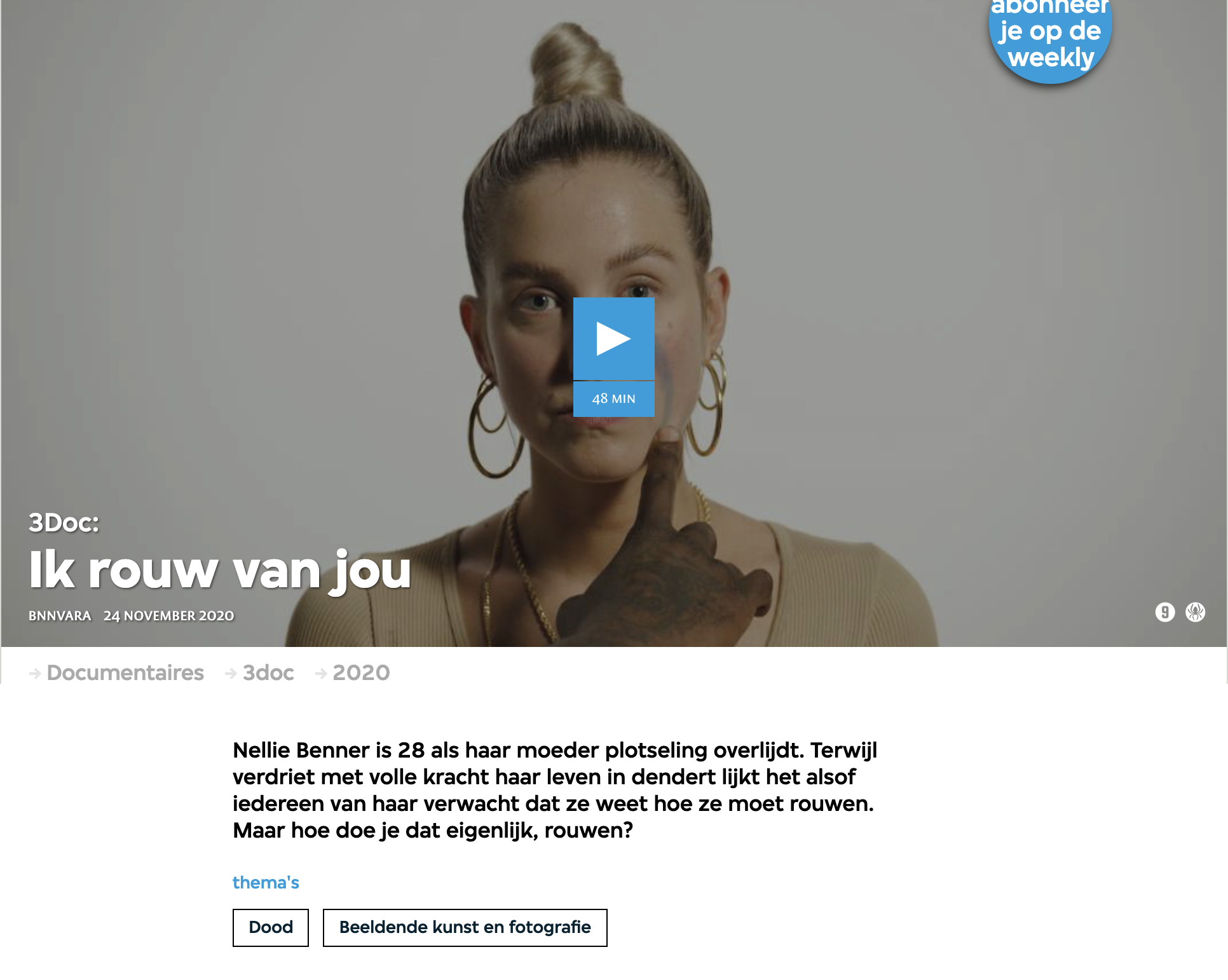
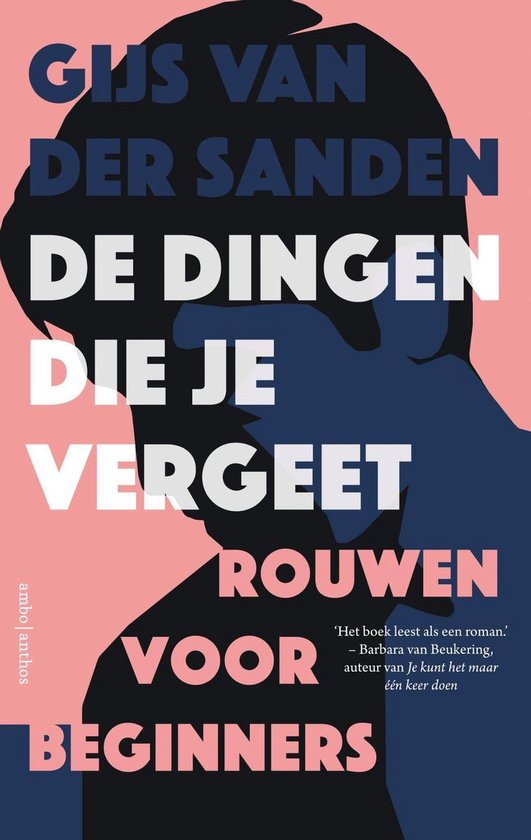
this is a book I've been reading. The title (translated) is 'the things you forget —mourning for beginners'.
the book is written by a young guy who lost both his parent in his early twenties, and it reflects on the loss, the memories, the thoughts. Each chapter has a different angle, some are short and describe a specific memory or aspect of the mourning, like relistening to the last voicemail of his mother over and over, or a detailed description of all he remembers of the day he heard the news.
It paints an engaging and livable perspective, really interesting read without being overtly sad or philosophic. My main reason for reading this book (from the research perspective) is that it talks a lot about a specific memory —that of the loss of a parent— and how it grows. It describes how it manifests itself in a life, how it can be embodied in a space, how it develops with time.
This view on memory, is what I am particularly interested in. I already played with some of these themes last semester, and especially wanted to seek more sources (that are less objectively academic or theorised) on this.
.
this is a documentary I watched.
the title (translated) is 'i mourn for you' (in dutch this is a wordplay on I love you).
this documentary came out in 2020, and I heard of it when it was mentioned at a digital film festival I was attending. the subject of mourning and memories had been on my mind, so this was a beautiful way in to this topic. the film itself is about the creator, who lost her mom in her twenties, and tells the story of how she is seeking to remember her.
The storytelling was very intimate, following the director in her life and in personal and open conversations with for example her dad and close friends. The perspective of telling this story in retrospect —she is looking back on the death of her mother a couple years later— gives the memory more shape. It again also sees how it manifests itself, more in her mind, her body, and her relationships, but the memory (or rather the processing of the memory through the mourning) is central in the documentary.
[LINK]
[LINK]
ARTISTS
REFERENCED / RESEARCHED
CHRISTOPHER CLARY
I first came across works by Christopher Clary in the research for my dissertation. His works exist in an archive structure, typically utilising the desktop as a playground, with a performative aspect. Whilst his themes —digital presence, sensuality online, and the culture surrounding porn— don't directly relate to my works, his ways of working do somehow.
For example, 'Sorry to dump on you like this.zip' recirculates the artist’s pornography collection and love letters. 1,860 jpegs tell a story filename-by-filename of love, lust, heartbreak, and banality from emails and text messages dated 1999 to 2015. Consisting only of still images and their filenames, sorry to dump on you like this.zip can be read as a dramatic desktop play that takes on an almost operatic depth, with characters, dialogue, and changing scenery. Multiple voices speak the texts. This archive exists as a zip file, as a flash drive, as a printed record, and as part of publications. It is a narrative, carefully collected, curated and presented, in this digital format. It’s tempting to call sorry to dump on you like this.zip a pornographic work since an actual porn collection is embedded within it. But these JPGs serve only as a substrate: thin scaffolding for an epic textual work that hangs loosely from the files. The nature of the work as digital and the ways how it uses narration (both direct and indirect) are very interesting. In Clary’s work, the paratextual spaces of the operating system (file names, dates, metadata, keywords) can perform unlimited narratives, if the player is game to save, search, and so. He uses a combination of text and images in his performances, which consist of nearly ritualistic acts. In this video, the artist performed the zip on his desktop. Downloading. Opening. Reading. Sorting. Dragging. Previewing. Resizing. Cleaning up. And trashing the entire archive causing the computer to crash. Here the indirect format for narration, and his careful play with the relations of online and offline —real and simulated— form the essential quality of the work.
This is what really intrigued me about the work, and what I wanted t explore in relation to my own project.
[LINK]
During a tutorial I had with Cristina, we got to talking about how text could become visuals. How you could tell a story, visually, through just text. How could text take the foreground, with no visual support, but still be formed as a visual art work.
She mentioned 'Chalkroom' by Laurie Anderson. In her works, text was used as the main visual language. In this VR experience, she created a space filled by text, on the walls, in the atmosphere, deconstructed and whole. As much as I dislike this work, for it does not let the text speak, but rather utilises into some VR architecture, the storyline is build up of a textual format. I think seeing for text was used in this work, was still interesting though. Whilst taking shape rather as decoration, than as a directed narration, it does showcase a unique way of putting language (almost like a code) at the forefront of the visual structure of an art work.
I am not necessarily experimenting with the use of text in this way, but the intentions Anderson had with this work could still play a role in my conception or research towards a final project. Clear examples of how not to do something, and more specifically being able to identify which elements don't work or actively work against the idea, can definitely be beneficial to the development of my project.
LAURIE ANDERSON
[LINK]
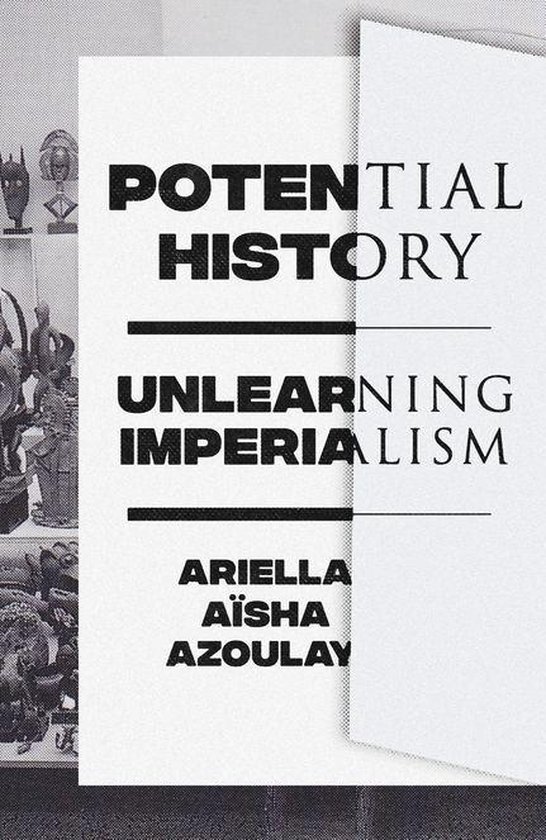
I read this book last semester, in the research process for my thesis, but find myself referring back to it constantly.
The book talks about history, archives, and their narratives and how they have shaped our lives today. Azoulay argues that the institutions that make our world, from archives and museums to ideas of sovereignty and human rights to history itself, are all dependent on imperial modes of thinking.
However more related to my research, it discussed notions of time and our perceptions of time and temporal markers. It is something that is very closely linked to memory, especially collective memory. One particularly interesting paragraph is about timelines.
The notion that time is a construct only held together by our notion of it is mainly what I took from it. This perspective in return is something one can also argue for memory, in that it does not exist if I do not remember it, an interesting thought on it self.
Connected to that, I want to seek ways of engaging people in such a personal perspective, in this case a memory.
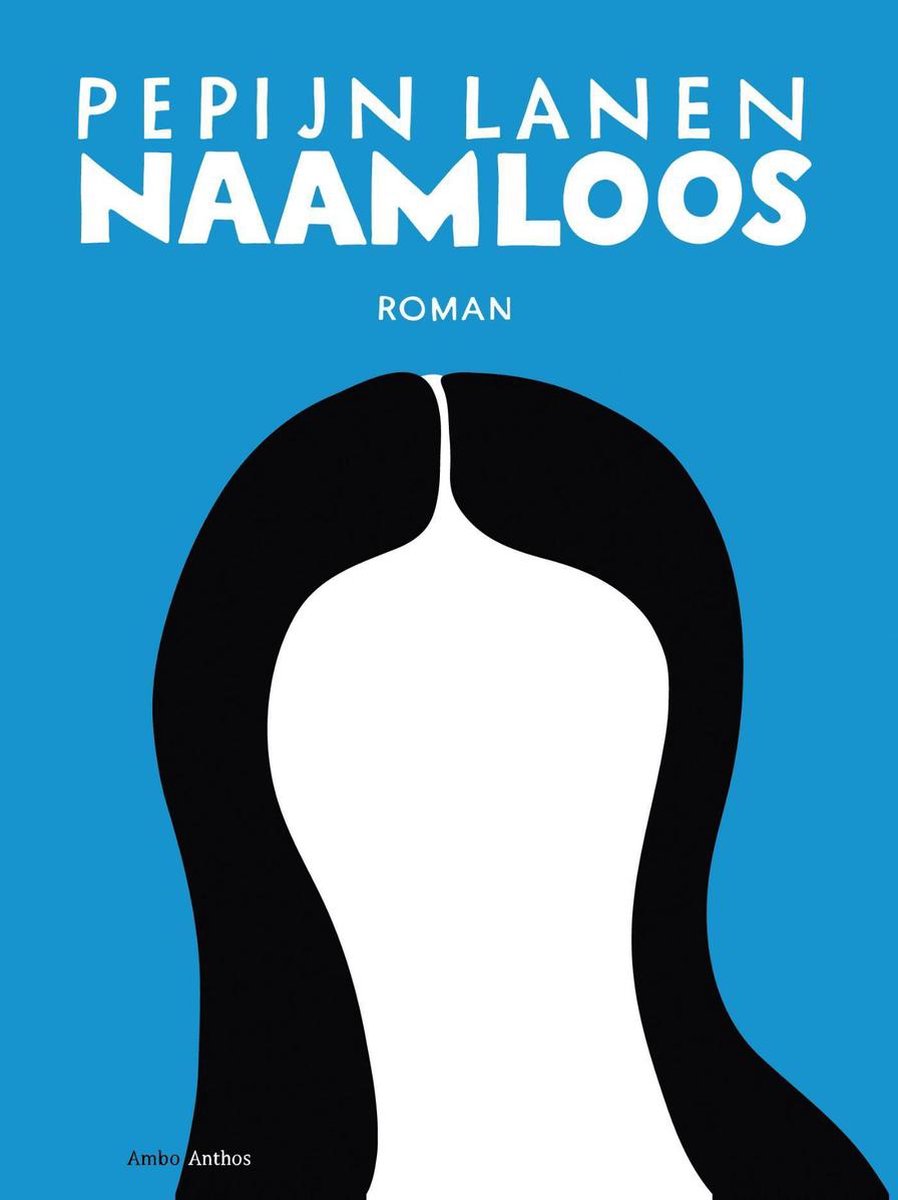
I came across this book semi by accident. The author is one of my favourite music artists (I have always appreciated his lyrics) but he also does a plethora of other things —like writing.
He actually recorded this entire book, chapter by chapter, on Spotify. I had never been much attracted to the idea of audiobooks, but hearing him himself narrate the book, made a lot of sense.
The book is about a nameless guy (as in we never find out his name) in his thirties, living in between jobs. But it is not so much the content, as the structure of the book that made me so intrigued. Each chapter is describing a different day. Starting on day 7. It jumps back and front in time, really playing with a notion of time in its narration.
That is the main reason why I am adding it to this page. The flexibility of time used in this book, put me to think. How I play with the concept of time (and especially developments over time) in my work is definitely now influenced by this book. When used in the right structures, this freedom of the use of time can help a story or narrative extremely. Where I was, in my work, originally mainly looking into the embodiment of the memory in space, the timely aspect was kind of left behind. But it is so crucial to the memory, and especially how it can then become embodied, and then engaged with. Without the time aspect, one can not map a memory in space, for without a sense of time, the memory did not exist at all.
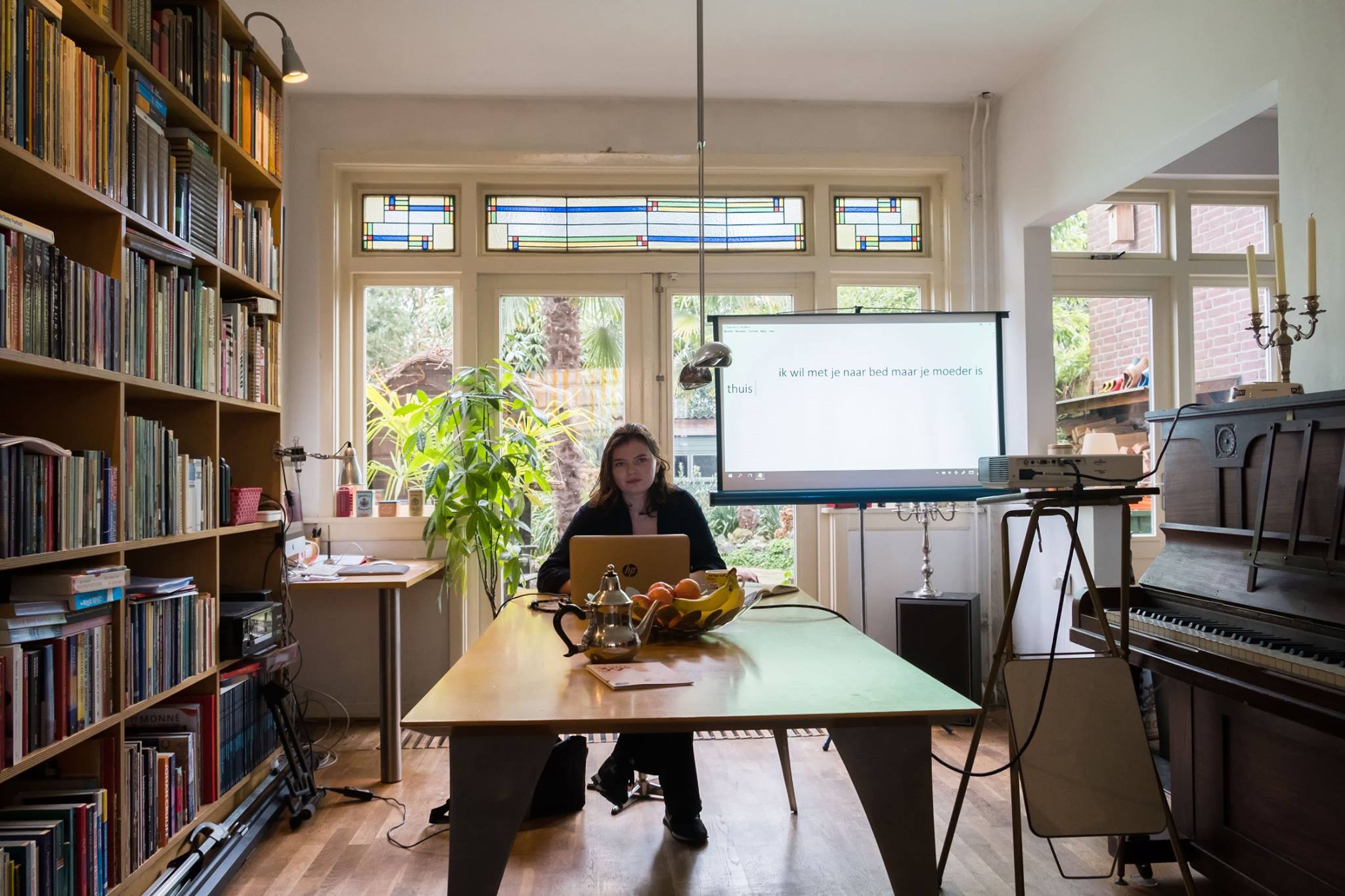
FLOOR LANGEN
a couple years back, I was part of the crew on a theatre and arts festival (still one of my favourite events, it had a 'livingroom route', with people performing in houses in the neighbourhood. The unfamiliar yet homely setup created an intimate atmosphere for each different performance. The program consisted of theatre solo's, dance performances and music)
One of my favourite performances that year was by Floor Langen. She performed on a page, behind a laptop with a projector. The concept was humorous yet intimate. She embodied the page as her stage, with some hints to desktop art, using just writing to narrate her performance.
The setup was simple but it made it approachable. It felt like reading over someone's shoulder, but being invited to do so. This way of telling a story, indirectly, but with a direct link to the audience is interesting. It gives room to be more open or honest, and create an even more intimate setting than through actual spoken words.
The time line is not a re-presentation of time, but rather a technological device operating with various degrees of tolerance. The imposing power of institutional time lines is such that for any narrative to sound accurate, it must be “situated historically”; for example, it must be anchored by the beginning or end of World War I or World War II; the creation of the state of Israel, or the United States, the Fourth French Republic or the Third Reich; the establishment of the first public library or national archive.7 Yet by relying on such temporal markers and declared missions of these institutions, such histories necessarily confirm them as objective descriptions. Time lines ensure that events, objects, and people are in their “right place”—temporally, spatially, and politically—so that scholars or laymen can confidently measure changes along time, evaluate novelties, judge directions of influence, assert originality, determine and devalue derivatives, differentiate the unprecedented from precedents, and proclaim turns and turning points.
[LINK]
MORE ARTISTS
REFERENCED / RESEARCHED
SOPHIE CALLE
During a , Piotr Sikora mentioned my work, or intentions and themes I was working with in relation to the works of Sophie Calle. Specifically her work for the 52nd Venice Biennale centred around a letter from her partner, ending their relationship. In this piece, she asked 50 different people to interpret, feel, and read the letter, and perform it in their own way or medium. This central focus of the text, whilst never really revealing it in its totality.
It plays with text as the foundation of the work, and the reconstruction of it through in this case video. It gives this personal content, and lets it be explored and re-interpreted by others. As described by a visitor of the show "In taking care, she invites others to provide explanations for the inexplicable rupture, or just lamentations in the spirit of lyric drama. By circulating the letter to women of all ages, artistic and otherwise, Calle transforms the breakup into a survey of interpretation.". The translations of this reality truly are as linguistic as they are visual. This quality, of letting this text further live on in the imagination and interpretation of an audience or the collaborators minds, is incredibly interesting. Not only as a medium for dialogue or bringing across a message, but also simply as a true output of the work, something I am further exploring in my work this semester.
[LINK]
JENNY HOLZER
When looking more into the use of language as a visual language in art, you can't skip jenny holzer. Her signature style is characterised by the simplicity and directness of her statements [the texts she uses as the fore front of her works] which she often appropriates from diverse sources or creates herself. Utilising strategies commonly used by businesses to advertise or sell merchandise, Holzer issues printed products such as pencils, decals, coffee mugs, T-shirts, golf balls, and baseball caps, as a medium for her art. A very approachable, and on the surface digestible format. Her work takes place in the real world, as part of everyday life. It is contextualised to contrast from the structures making up our usual experiences, and make bold statements or commentary.
As much as this is not a direct link to my work, I do see use in analysing some of the strategies Holzer uses in the textual aspects of her work. Why do her statements work, why is this medium so intimate yet upfront, so honest yet approachable.
Text is a such a direct medium. Or rather, it can be. There are so many different ways to say something, to phrase something, and to display text, and all of these elements play such a big role in how it is accessed and perceived. Whilst my work is probably seeking for the exact opposite intentions as Holzer's, some qualities of the format overlap. Text is a great medium for direct narration, or a conversation that initially is one-sided, but might open up a discussion or thought.
MORE READING
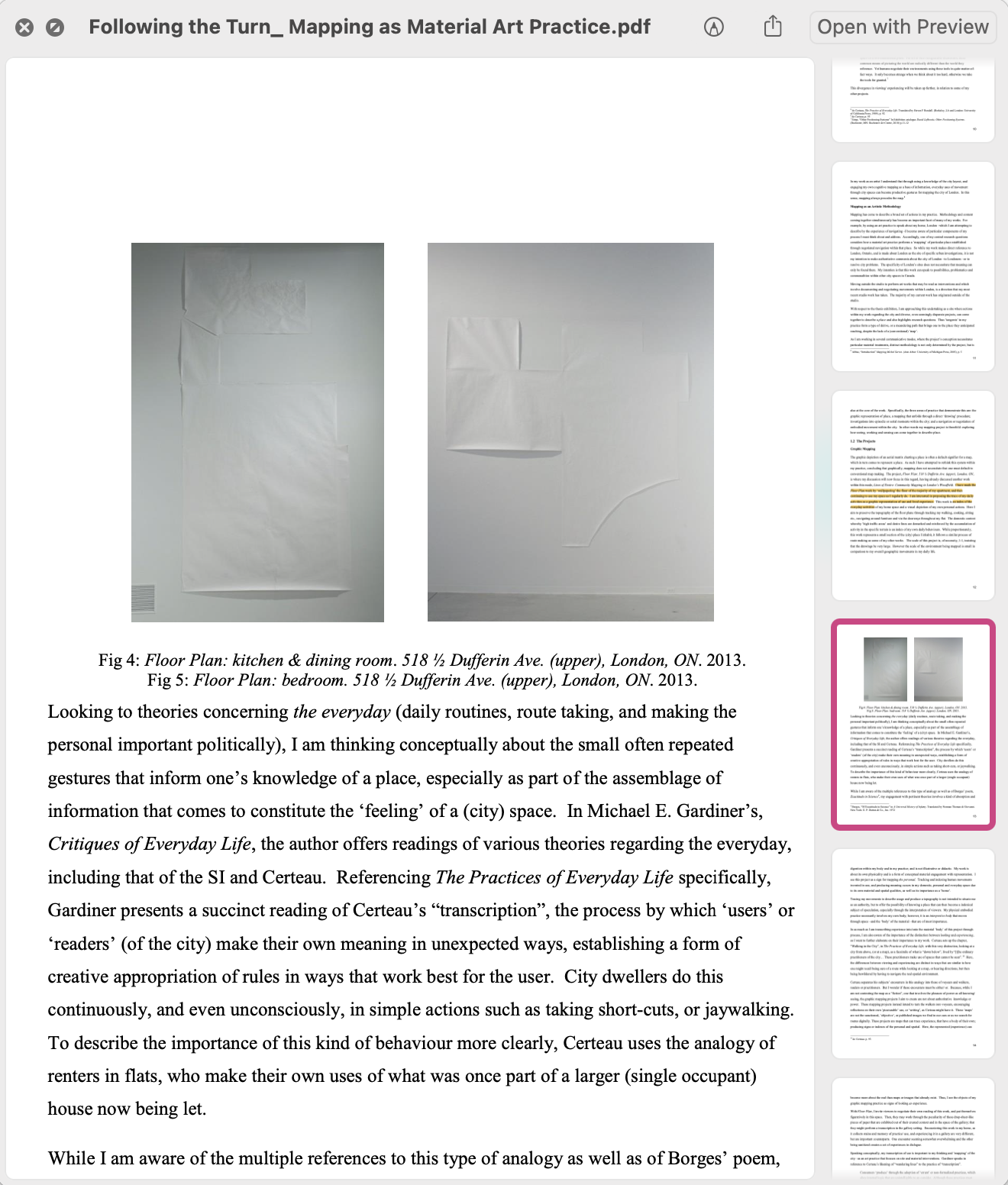
As part of the research for my final project —focussing on a performance of a memory, embodied in space— I sought out sources on mapping as an artistic act. One of the papers I read was ‘FOLLOWING THE TURN: MAPPING AS MATERIAL ART PRACTICE’, a thesis dossier by Kyla Brown (MFA, The University of Western Ontario). In it, Brown discusses how performing mapping of negotiated experiences in space is at the foundation of her artistic practice and research. She discusses different theories, along examples of her own practice, both in studio and outside spatial context. She introduces the tactic of mapping in her practice as follows;
“Mapping as material practice is the methodology with which I am investigating and invoking both perceived and underlying tensions. I am fundamentally questioning how my practice can invite nuanced considerations of a personal and shared experience of a city.”
In this perspective, where mapping is a central tactic to an artistic practice, but also fuel for it —in research but also in artistic expression or direct output— is an interesting and contrasting perspective to traditional uses for maps and mapping in the art ‘world’.
Further, Brown argues that mapping is;
1) Always representation. What does it mean that to ‘know’ a place; must we prioritize representation over a lived experience?
2) A tactic, or process, to find one’s way through real and described space. Here, markers of the city site are investigated and questioned materially and serially
3) A negotiated navigation of a ‘body’ within space. Here way finding, and relating to environmental concerns figure into my video practice that engages with local terrain and mobility.
This in itself is the core of the boundaries of what mapping is or can be in ones artistic practice. I think this is especially influential for my initial research, but also ultimate formulation and experimentation with this new artistic strategy.
Mapping as an Artistic Practice
an Essay on Mapping; MOMA
This is an essay by Robert Storr, published in conjunction with the exhibition Mapping at The Museum of Modern Art (New York, 1994). It was a document I came across when initially researching the use of maps and mapping in art, and it served both as a great overview, with lots of examples of the previous use of maps / mapping, but also provided some great insights into mapping as a medium (even from this older time). Whilst the exhibition itself (from the documentation I saw + reviews I read) was incredibly mediocre, this text went into some more of the nuance behind the format of a map.
In the text, Storr revealed how maps and map imagery serve as source and inspiration for contemporary artists. Giving examples from the exhibition, including thirty paintings, drawings, photo-composites, sculptures, and installations by as many artists, we are presented with a group of artists working in a wide variety of media and from a range of aesthetic perspectives. For artists of recent decades, Storr argues, maps have provided—symbolically, metaphorically, and graphically—emblems of power; realms and mazes to be explored; abstract forms to be manipulated; and the shapes of dreams. Artists in increasing numbers have taken up the map as an expressive medium. In an ageless and less enamoured of traditional forms of representation – and increasingly critical – maps have numerous attractions for artists. Beyond their formal continuities, maps and paintings are both communicative, that is, constructs intended to affect behaviour.
This communicative aspect of the map, in that it documents or tells the story of movement, of liveliness, is an especially interesting one. This is a definite aspect I'd want to further explore in my work.
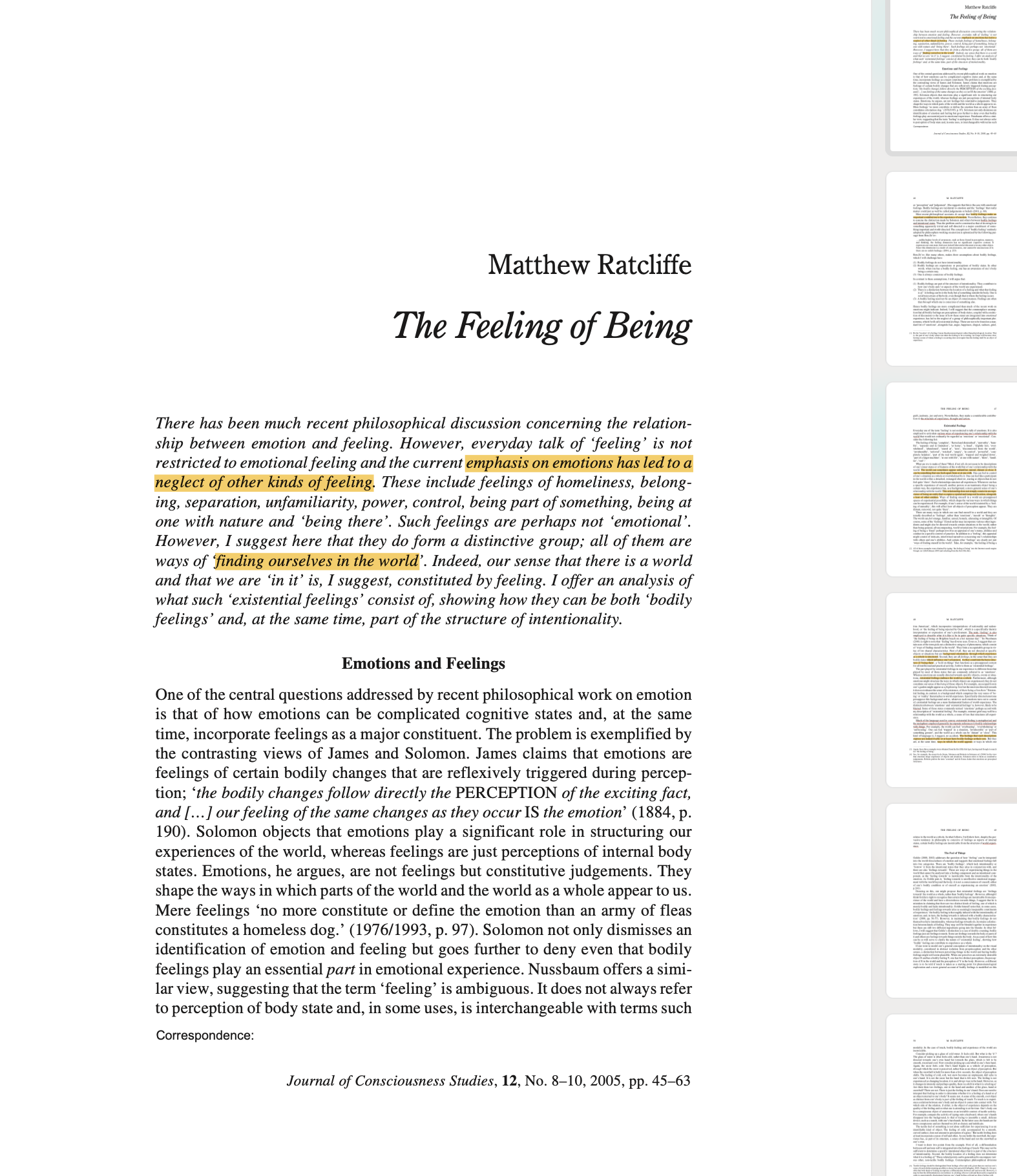
theories of Phenomenology
In my research towards the performance, I looked deeper into theories regarding phenomenology and spatial awareness related to embodiment. I had had a discussion with Keya about some of these themes and she sent me some texts she had read in the research towards her thesis. One of them ‘The Feeling of Being’ by Matthew Ratcliffe. In this text, Ratcliffe discusses the relationship between emotion and feeling. He discusses different perspectives and opinions on the experience of emotions, specifically regarding the argued contrast between bodily feelings and emotional states.
In this passage, Ratcliffe tries to expose the relationship of feelings and the outer world. He argues, this does not simply consist in an experience of being an entity that occupies a spatial and temporal location, but that a bodily experience is at the core of it.
“Everyday use of the term ‘feeling’ is not restricted to talk of emotions. It is also employed to articulate various ways of experiencing one’s relationship with the world that would not ordinarily be regarded as ‘emotions’ or ‘emotional’. What are we to make of these? Most, if not all, do not seem to be descriptions of one’s inner states or of features of the world but of one’s relationship with the world. The world can sometimes appear unfamiliar, unreal, distant or close. It can be something that one feels apart from or at one with.”
I See/you Mean
This is a book I was recommended by Cristina. In it, Lippard is essentially describing photographs. It is trying a very similar thing to what I am trying to do in my work. Bringing across an image or memory or feeling connected to something the audience can not see or access. For me, this memory, and this room, for her, the photographs.
I was only able to read a couple of stories from this book but the way how Lippard used language and told the stories was incredibly interesting. This feeling of truly activating both a memory as well as my personal imagination is very intriguing. I hope this is something I can further explore in my work or invoke with my audience.
SHEIDA SOLEIMANI
When further exploring how art can exit on the desktop, I came across another piece commissioned by rhizome for their 'the download' [I initially came across these works for the research of my thesis]. 'to oblivion.zip' is Sheida Soleimani’s downloadable memorial. It exists as a desktop lamentation, available for an audience to explore through a downloadable zip file.
"This work by by Sheida Soleimani, laments the death of Reyhaneh Jabbari, who was convicted and hanged in Iran on October 25, 2014 for the alleged murder of her rapist. to oblivion.zip, a dirge-like work that eulogizes Jabbari’s untimely death, consists almost entirely of Jabbari’s own written and spoken words. Once expanded, the ZIP file presents a multi-layered work of nested folders that contain execution records, letters, photographs, and voice recordings. How do we mourn online? Physical displays of grief, like crying, wailing, or pounding the chest, even falling to the ground, are gestures that haven’t found their digital equivalents just yet. to oblivion.zip shows how lamentation might take another form: a network-based publication that translates a public display of loss into an intensely private, albeit shareable, experience. By opening up these files and filling the local desktop with letters and images, the conditions for memorializing the dead change each time, the arrangement and layering of windows allowing for different, shifting views of the deceased’s story."
[LINK]
....a selection of accessed sources